Successful wild dog call-ups
Day 13 - Successful call-ups
This morning, our last full day, we returned immediately to where we’d left the nyala leg. We had no fresh bait today. The leg was still chained to the tree, seemingly untouched, but fresh elephant and dog tracks were here too, over our truck’s tracks from last night. Hayden wondered whether the “ele”s had scared ’em off. We reverse away from the leg and set up the speakers, while Joris scans. A little twitter rings out, then we wait. Like before, they seemed closer, beeps were louder. We edge forward for a better view.
And there they were. The dogs, at long last, the 3 escapees – Elsa, Finn and Poofie, no sign of the puppy. At last a confirmed visual, after days of effort we could begin. When they saw us they looked to run; we reversed back, waited, and played the audio again. They returned to the meat, to finish their abandoned meal. While one fed the others were moving, always looking around, checking their surroundings. We edge closer, they skip away, we wait, they come back again, we repeat the process – each time getting closer, each time the dogs growing more accustomed to the presence of us and the truck.
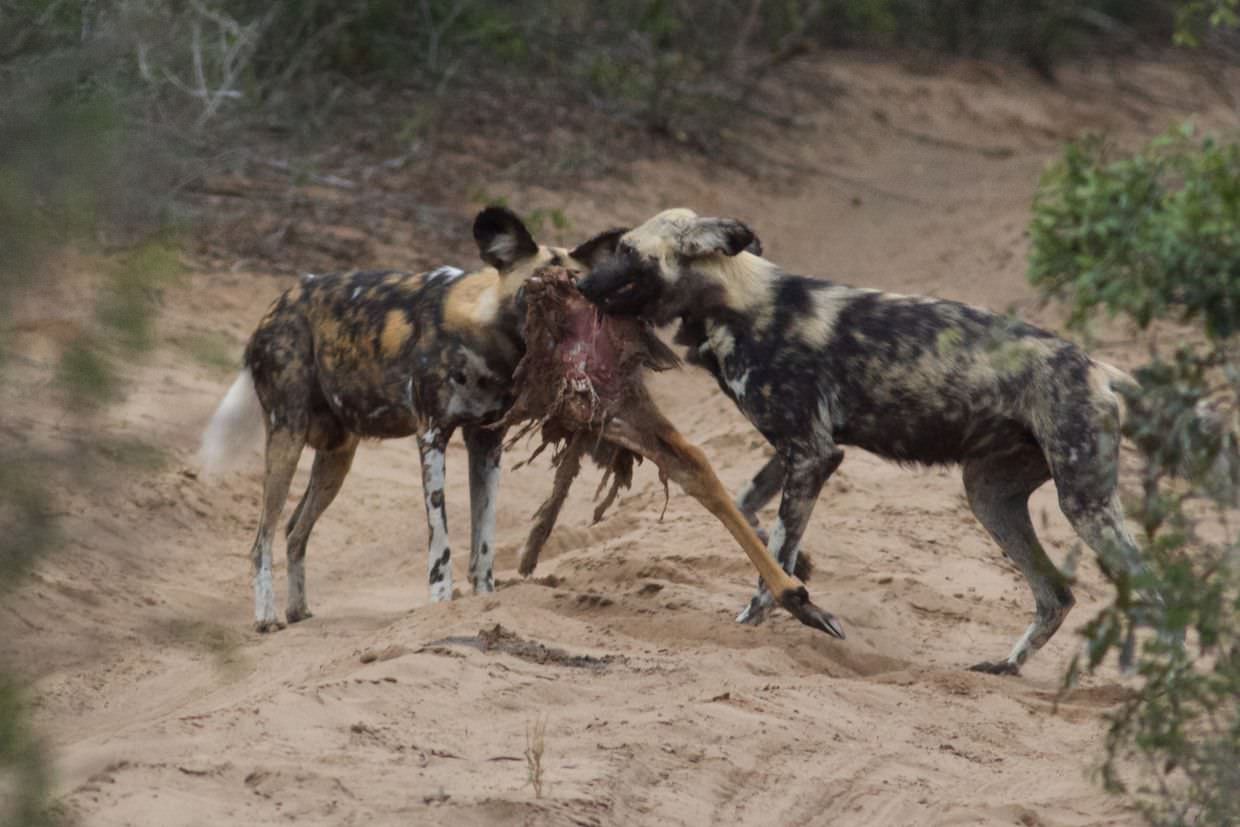
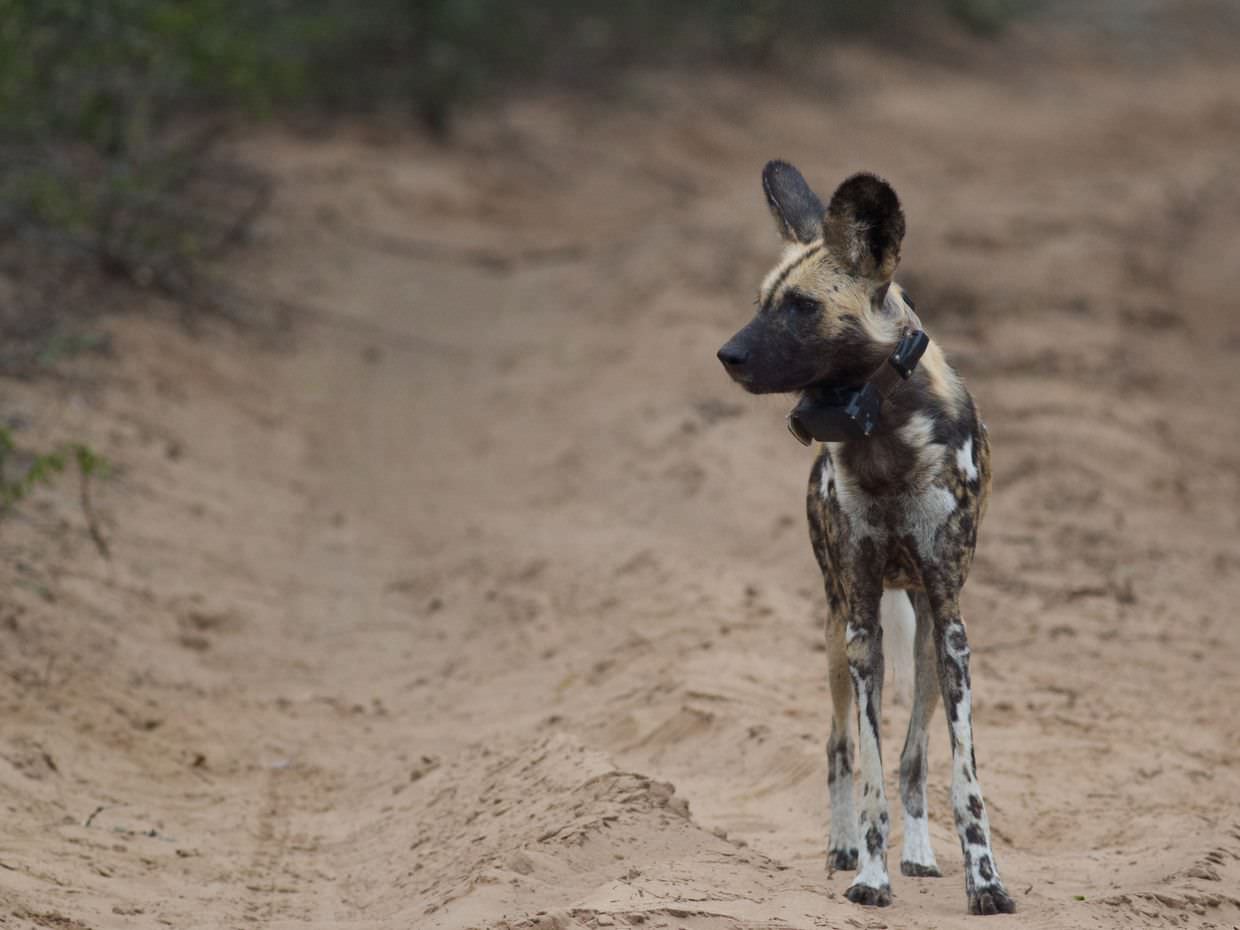

Courtship at camp, kudu burgers at the lodge
From the kitchen I heard a peculiar clicking and clucking noise, and the odd whirrrr. I traced the noise to a shrub outside. Peering in, I could see a bird sitting patiently on a branch, beneath her, another, a male – he danced heroically, clicking, whizzing and bouncing from tree to tree, trying to woo and impress her. They were green-backed cameraopteras, a pleasure to watch, though he wasn’t successful.

It was around now that Peter and I also started the great plover debate. How do you pronounce plover? Is it plover – like lover, or plover, like clover. Turns out we aren’t the only ones, and a quick Google revealed the same arguments online. We agreed to a British way and an American way on the way to the lodge for lunch.
Hayden had told us all about the kudu burgers; this was our last chance to try one. We booked a table for 6 and each of us had an accompanying milkshake. Samanga monkeys, crested guineafowl and nyala hung around the restaurant.

Another success
After eating antelope ourselves, we left for another call-up session, a leg of frozen nyala bait in the back. On arrival we found their signal had moved, they weren’t near the crossroads, they’d headed further west, to the perimeter. On the border road we drive fast, passing herds of feeding elephants, closing down on the dog’s signal. We slow for a newtonia tree in the road, and stop to scan again.
Lynn scans, the signal is strong, 11, 12 o’clock she says. We look ahead, along the road, and here they are, coming our way. We drive towards them and they scatter into the grass, but they don’t go far, they’re watching us. Now for one of Hayden’s tricks; he asks Lindsey to watch them, to make eye contact with them, and while they’re watching, to drop the leg from the truck. The dogs know the meat came from us. We reverse and wait.
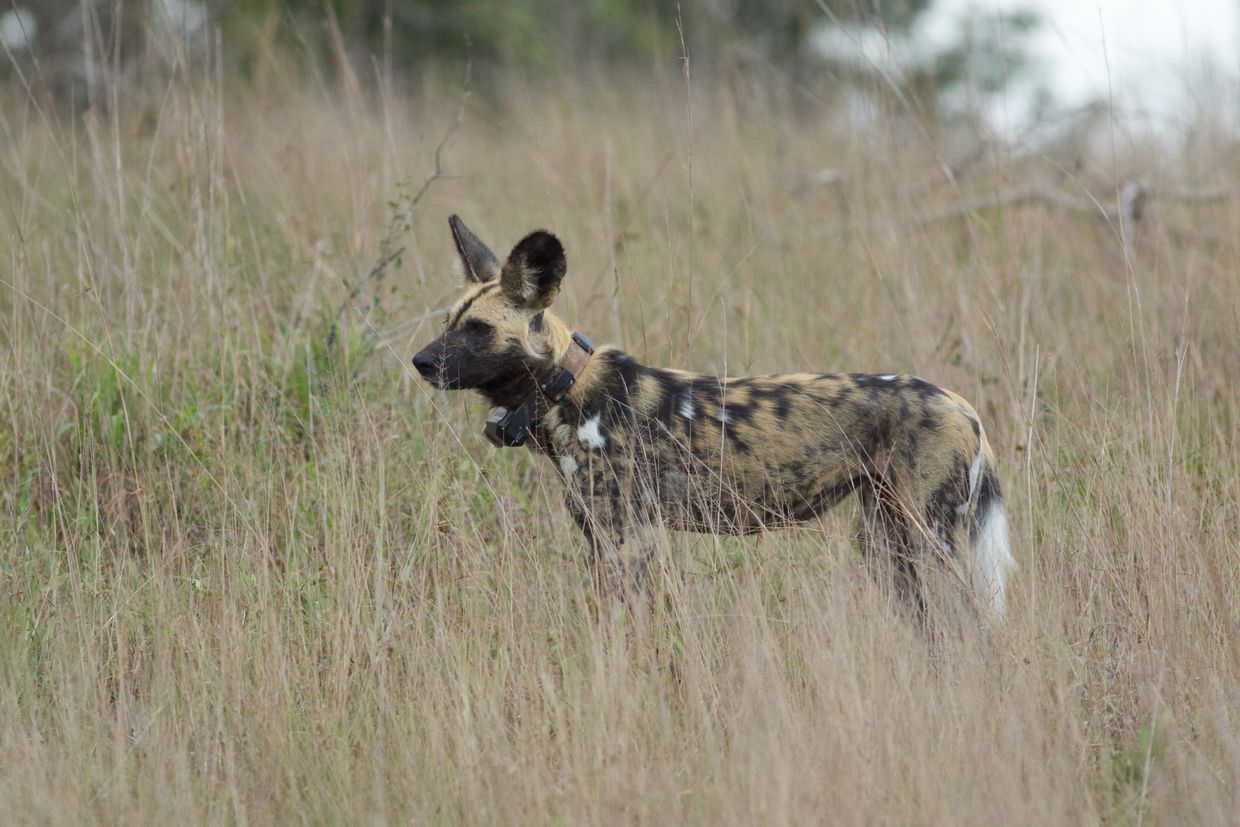
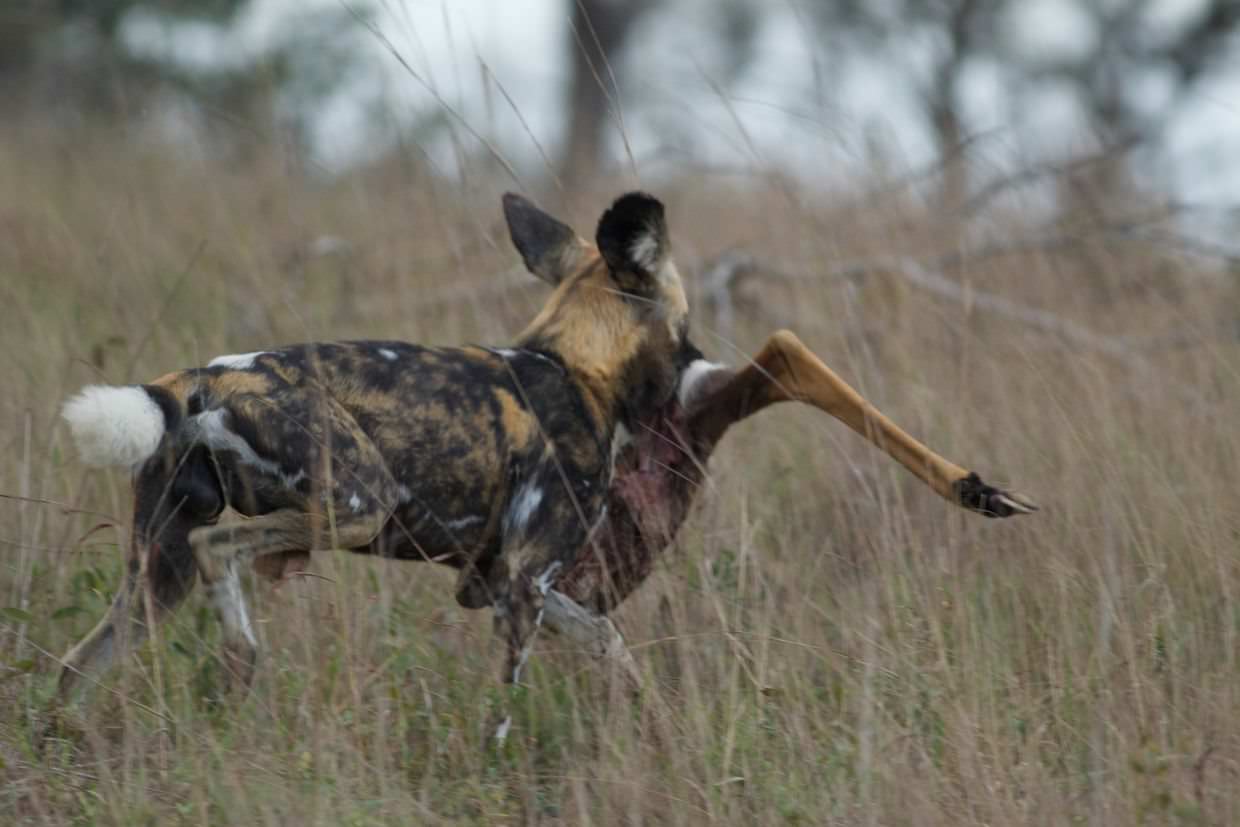
Cautiously they move-in, they grab the leg and drag it to a safer place. We follow them, taking the truck off road, over grass, bumps and rocks, to get close to them. We continue the habituation, keeping close, making them comfortable. Hayden revs the engine a little, a noise they shouldn’t be afraid of. We watch them feed, and in the long grass we have a photo opportunity; it was idyllic just watching them, in the dimming evening, our time in Tembe coming to an end.

We had to drive back along the border fence to get home. Some of those elephants we’d sped past were now much closer, one fed from a tree right besides the road. We needed to pass, this could be awkward. She was small… ish, and nervous. We move closer, carefully creeping forward, she’s not happy – she pulls back, lifts her leg and flaps her ears. We wait, unsure what she’ll do, wary of alarming her more. Then we creep closer still, trying to squeeze past, all of us silent. We’re almost clear, and she lets out a poot from her trumpet, but we’re clear now, and heading into the distance, hearts palpitating.
Day 14 - A final feeding
On our last day it was a late start, 5:30am, and only I went on session; the others had a lie-in or needed to pack. Hayden and I head out by ourselves, a trip to the mortuary to pick up a 3 legged male nyala carcass – we lifted it by its horns onto the back, then drove on to the boma for a feeding session.
For one last time I went around the boma perimeter, checking for electrical faults, signs of digging and tracks. We drove inside the boma and did the same, checking for holes, filling some in with sand and spades; the boma ritual completed one final time.
We pushed the nyala off the bucky and tied it to a tree with a chain. Above it, in the tree branches, I angled my go pro – for an up close view of how they feed. The dogs raced in as we drove away, frantically feeding as they do; Frankie – the pack’s outcast, she has a black tail and lots of black markings – waited her turn. The troupe of yellow-billed kites at the boma had grown to 11, and two fish eagles circled as well. 4 woolly necked storks waited their turn on the carcass.
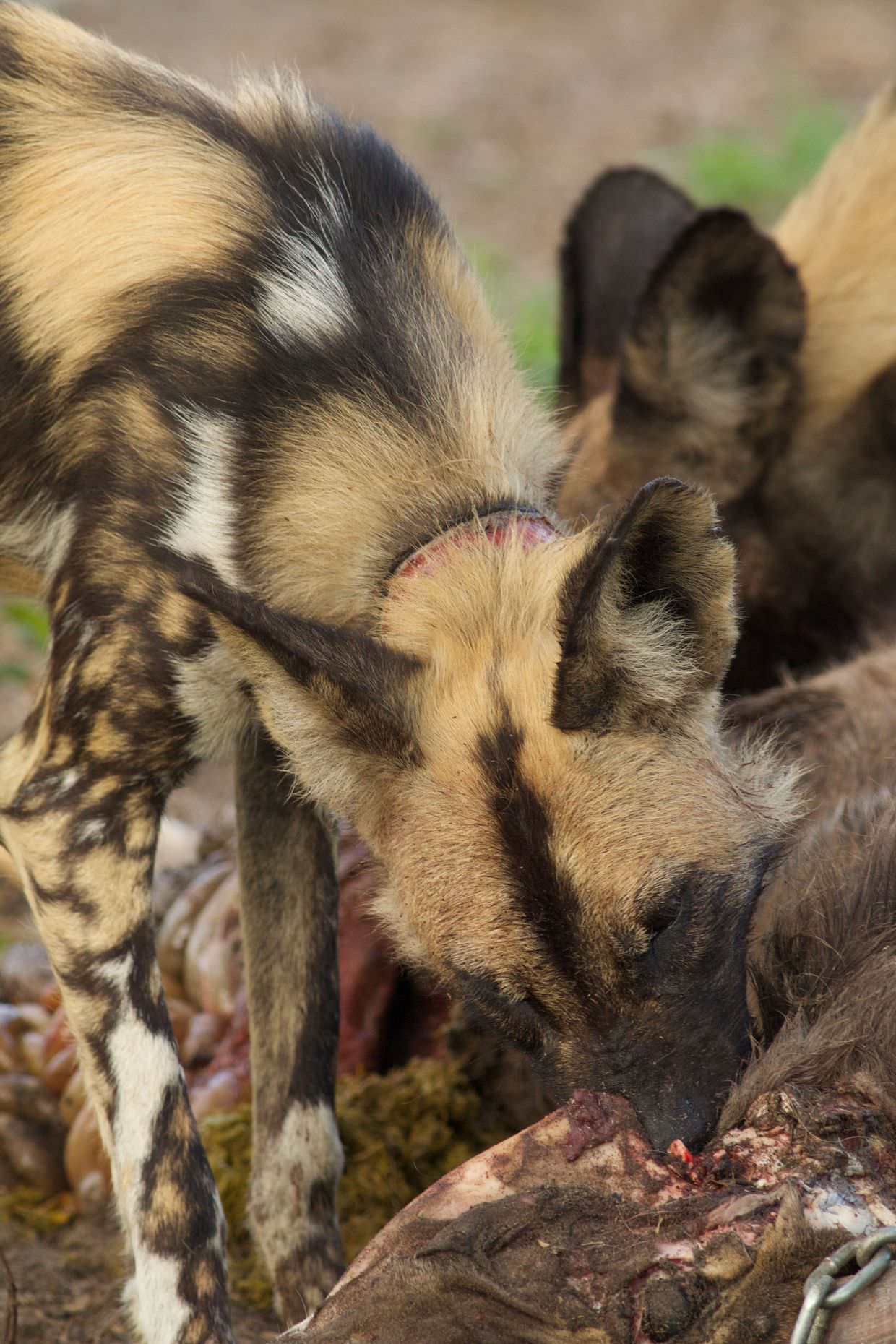
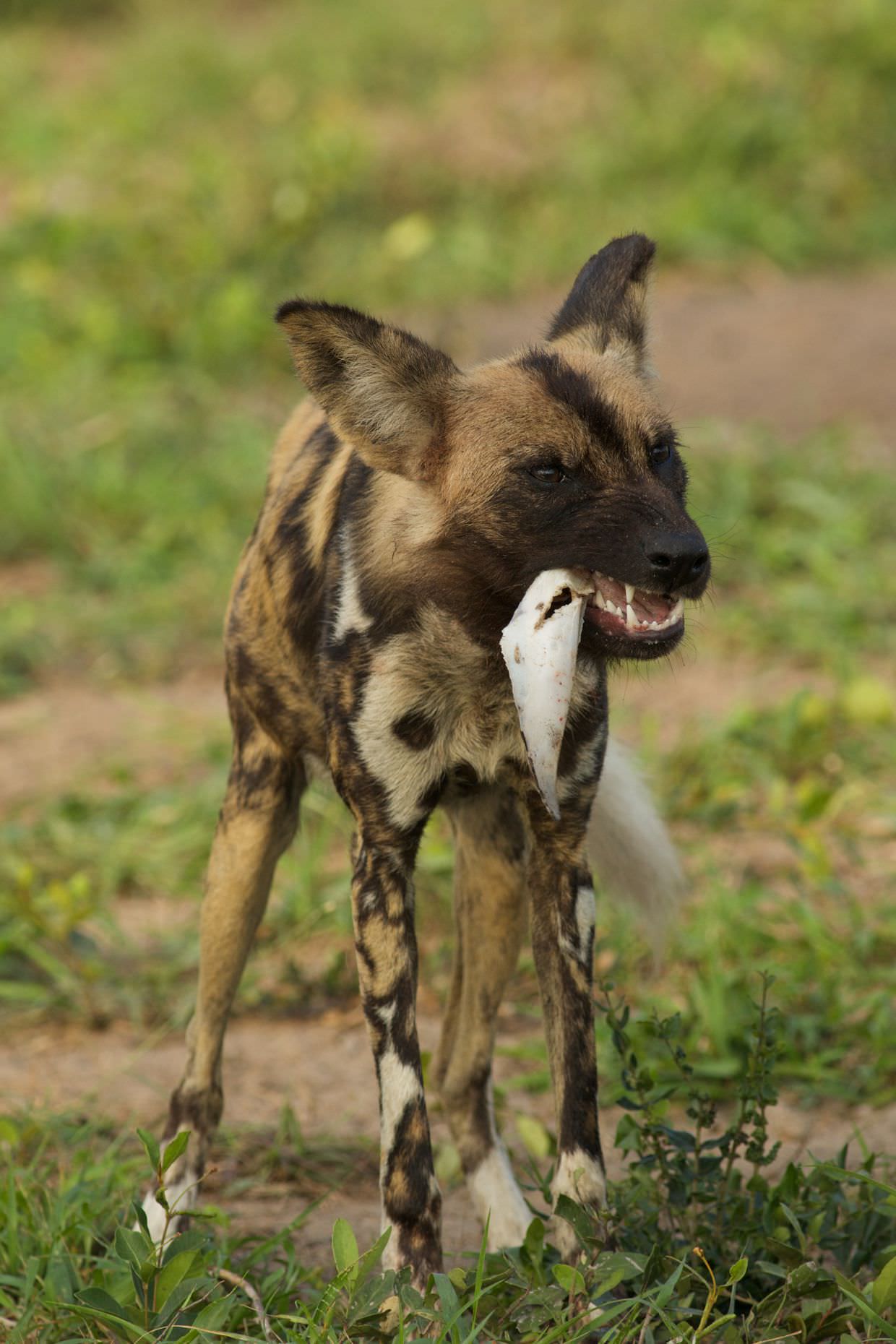
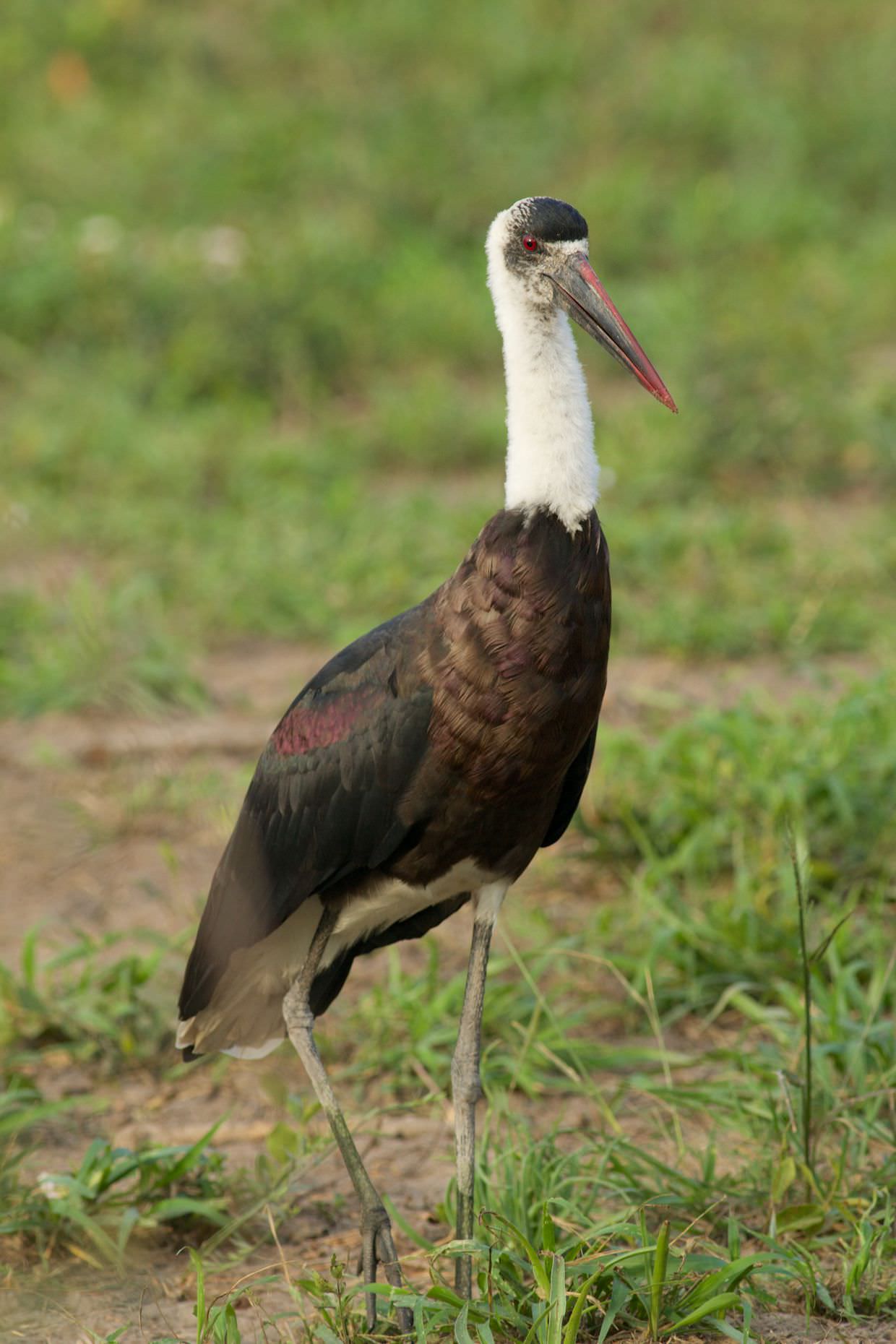
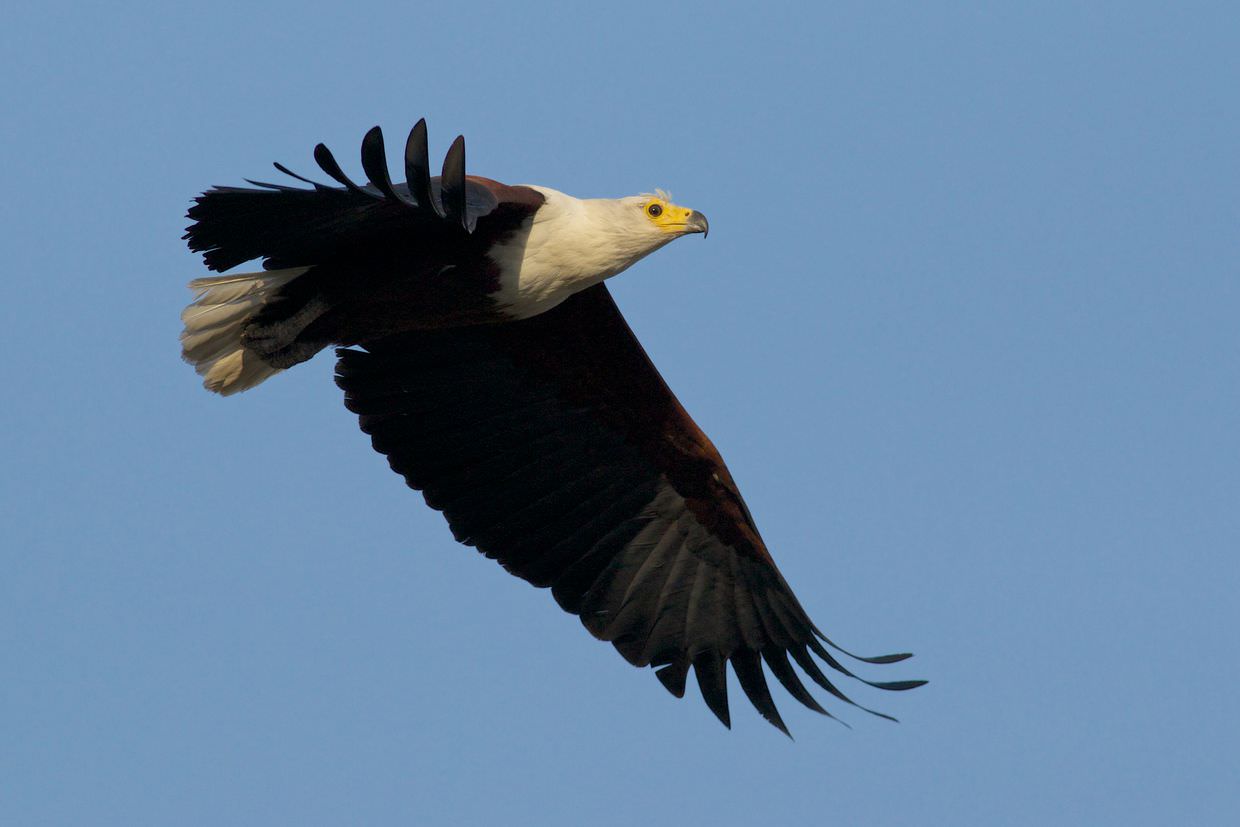
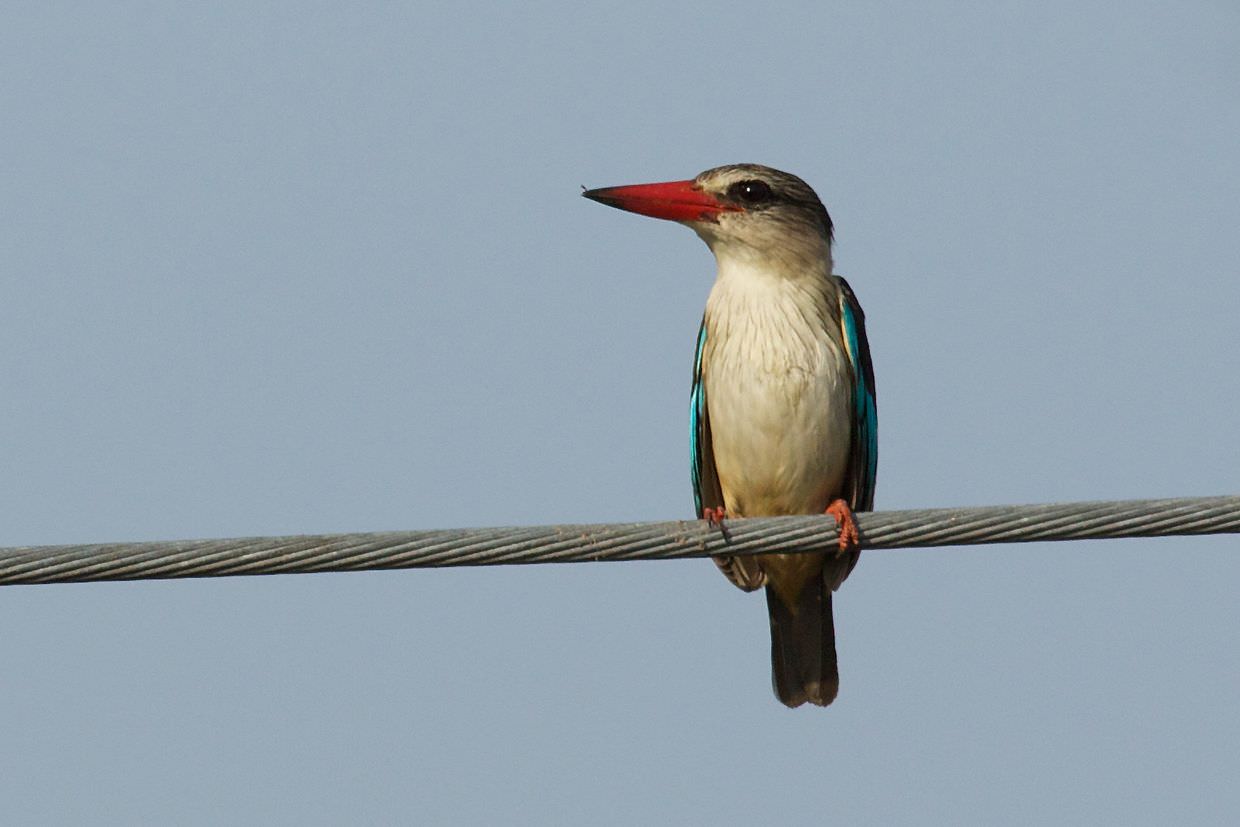
Half an hour later there wasn’t much left on the nyala; the dogs and birds had eaten and it was time to go; time to head back to camp, to grab my bags and hop onto the minibus. I’d be going onwards to Mkhuze, Joris would join me. I’d just enough time to make one last cup of coffee, and to take a group photo. Leo came to say farewell.
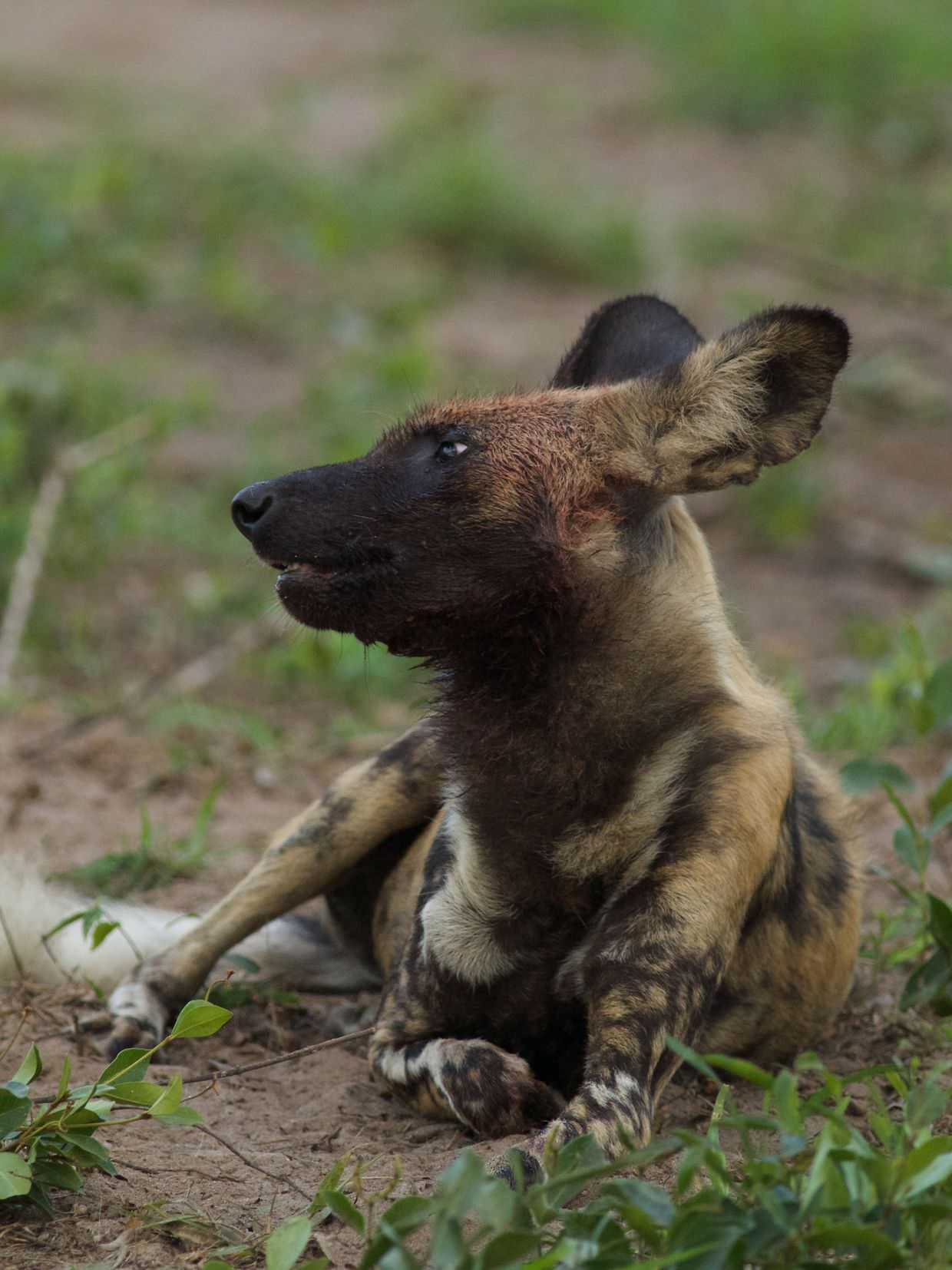
Tembe is a fantastically beautiful place, every road and every tree looks idyllic. It is sad to leave these dogs, I’d like to know how their story ends – it’s amazing how you bond with them. 3 in a boma, 3 on the run, a puppy never seen again. Over the next 5 weeks volunteer groups continued the habituation process, and when the vets came in they caught all the adults dogs successfully; with the whole pack in the boma they could now be moved, and at last begin their journey to a new home. Assuming nothing else goes wrong.
Species spotted
Mammals
- Lion – male, female, cubs
- Elephant – tusker
- Zebra
- Giraffe
- Slender mongoose
- Banded mongoose
- Vervet monkey
- Samanga monkey
- African wild dog, painted dog, puppy
- Wildebeest
- Impala
- Nyala
- Kudu
- Reedbuck
- Red duiker
- Grey duiker
- Buffalo
Birds
- African fish eagle
- African stonechat
- African yellow white-eye
- Bateleur
- Black-bellied bustard
- Black-chested snake eagle
- Burchell’s coucal
- Cinnamon-breasted bunting
- Collared sunbird
- Crested francolin (sound)
- Crowned eagle
- Eastern nicator
- Egyptian goose
- Green (red-billed) wood-hoopoe
- Grey heron
- Hamerkop
- Lilac-breasted roller
- Little bee-eater
- Little sparrowhawk
- Long-crested eagle
- Marico sunbird
- Purple-crested turaco
- Red-billed oxpecker
- Southern banded snake eagle
- Southern black flycatcher
- White-bellied sunbird
- Woolly-necked stork
- Yellow-bellied greenbul
- Yellow-billed kite
- Yellow-throated longclaw
Other
- Hingeback tortoise
- Rock monitor lizard
- Assassin bug nymph
- Flattened giant dung beetle
- Orange spider
- Rock python
- Thread snake
- Worm snake
- Lapwing and eggs
- Robberfly
- Heady maiden – Black winged bug with red stripes
- Orthoptern – common red-leg grasshopper
- Potter wasp
- Grass hoppers
- Garden acraea
- Black spider at hide
- Swallowtail butterfly
- Orange-tipped butterfly
- Black butterfly with four prominent white dots
- Misc queen ant, giant
- Velvet ant wasp